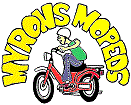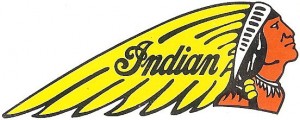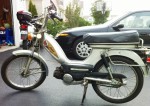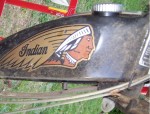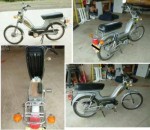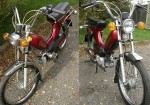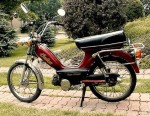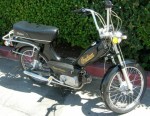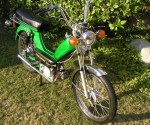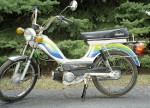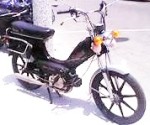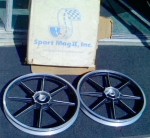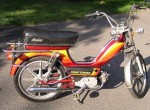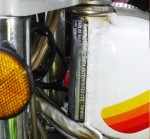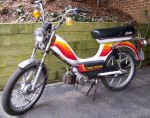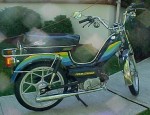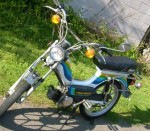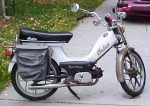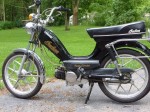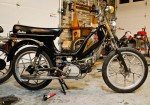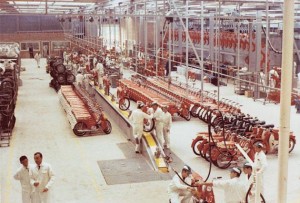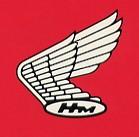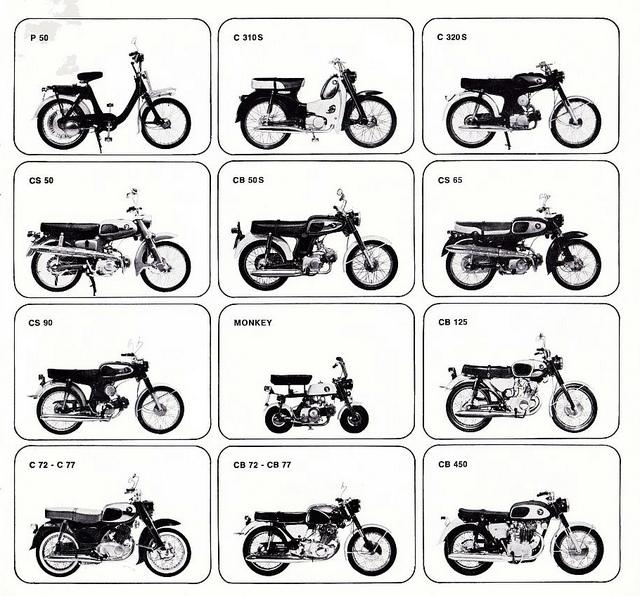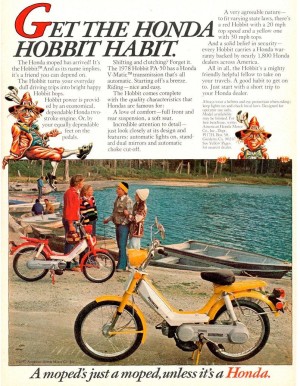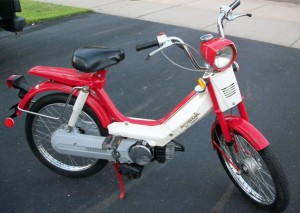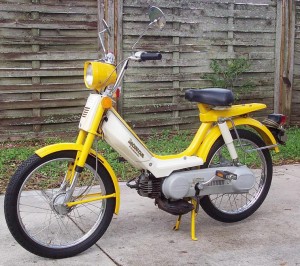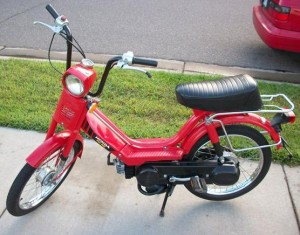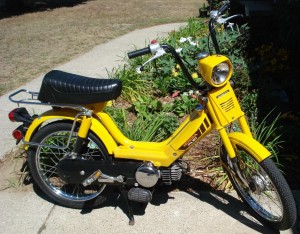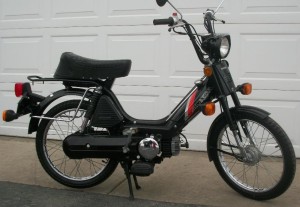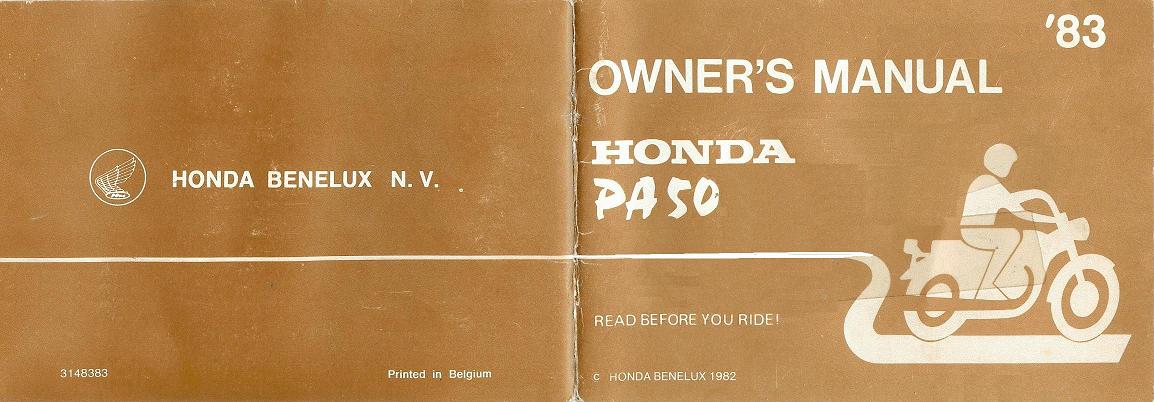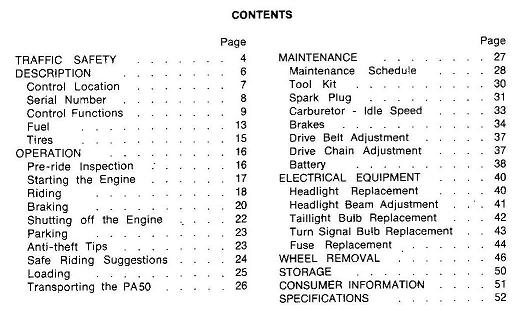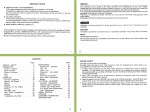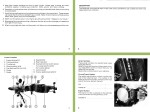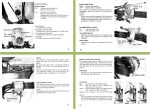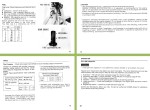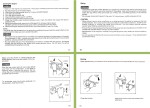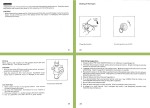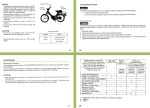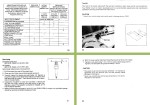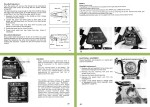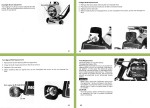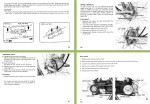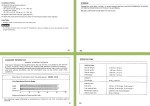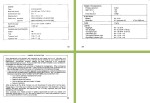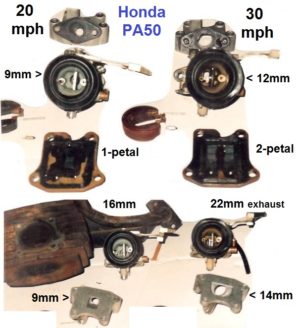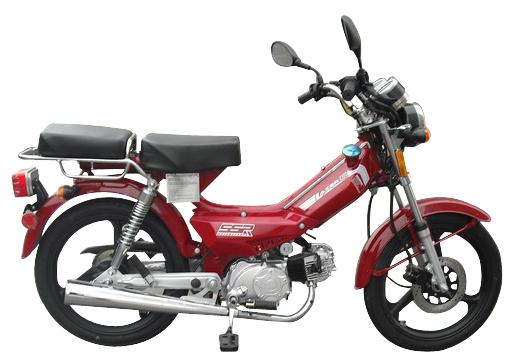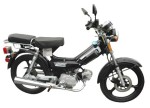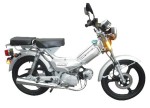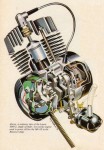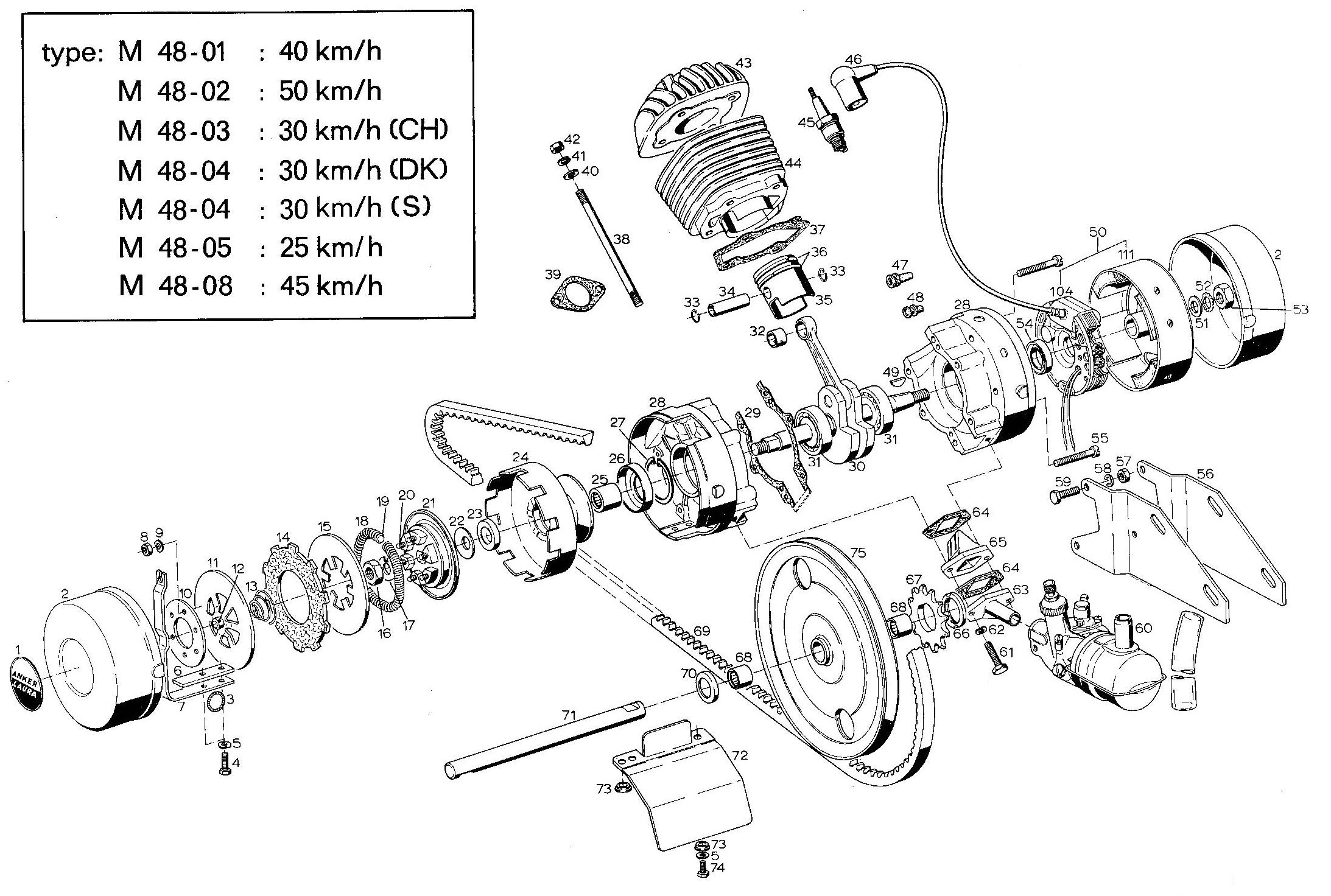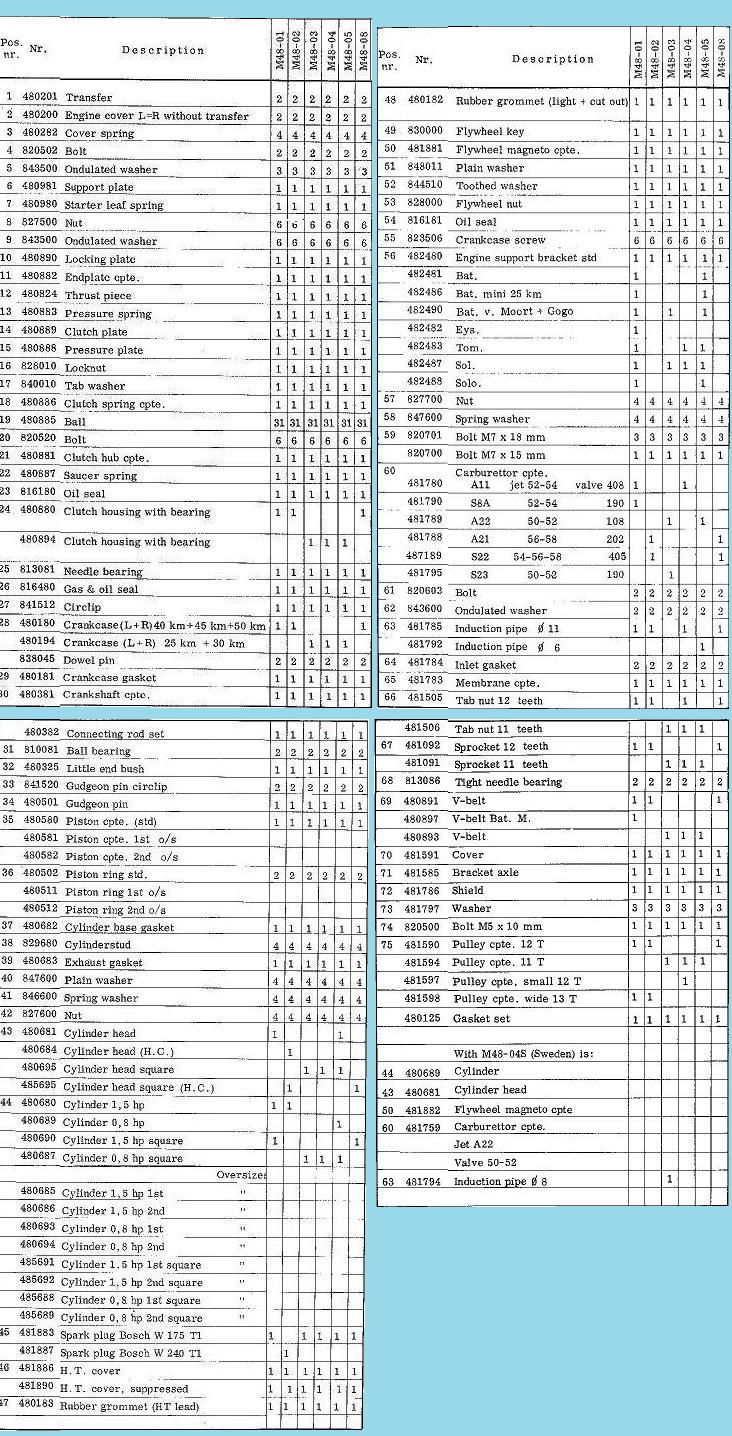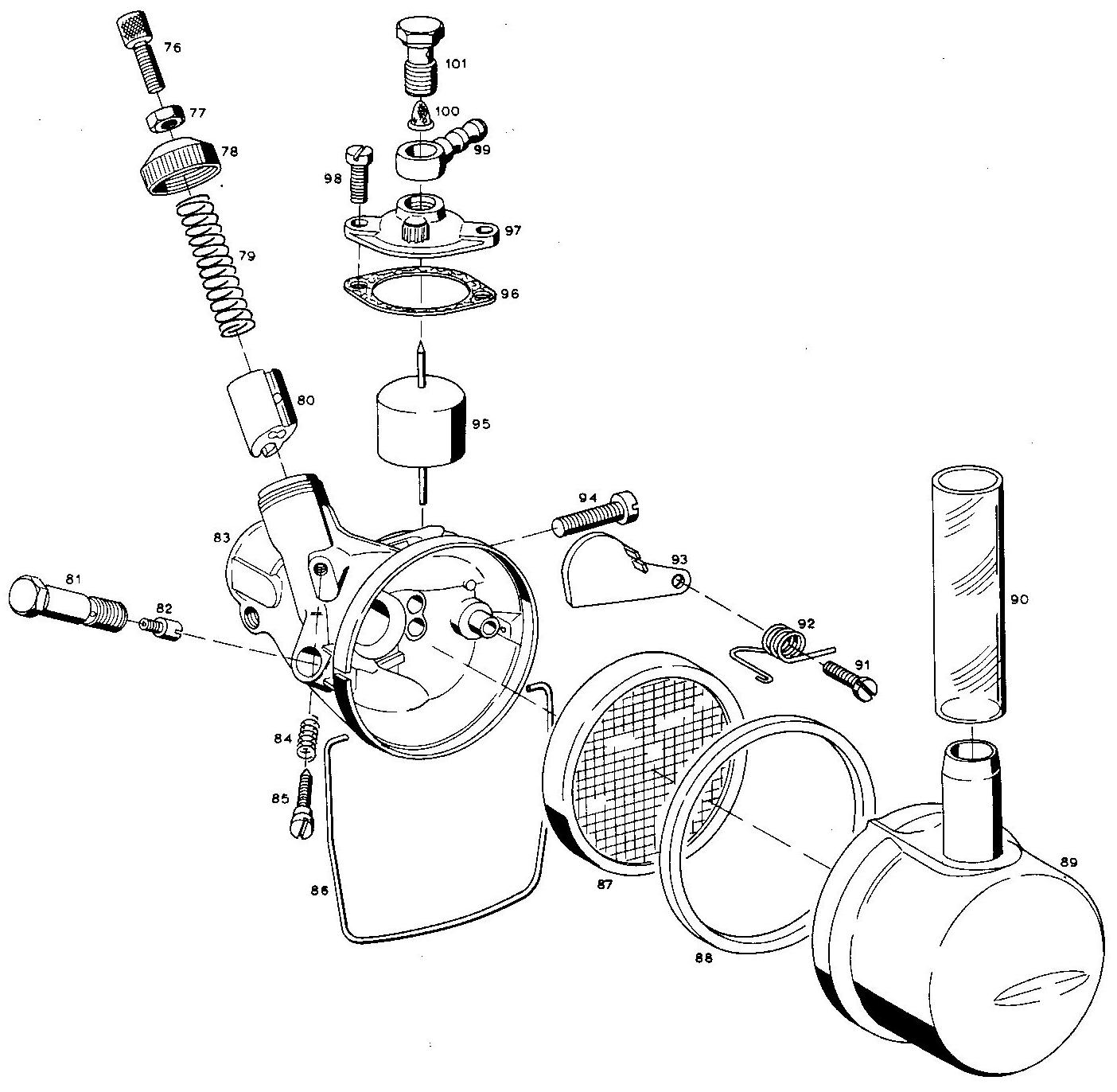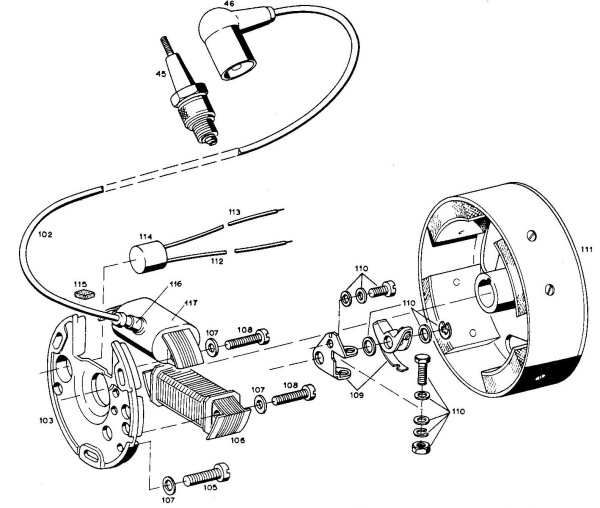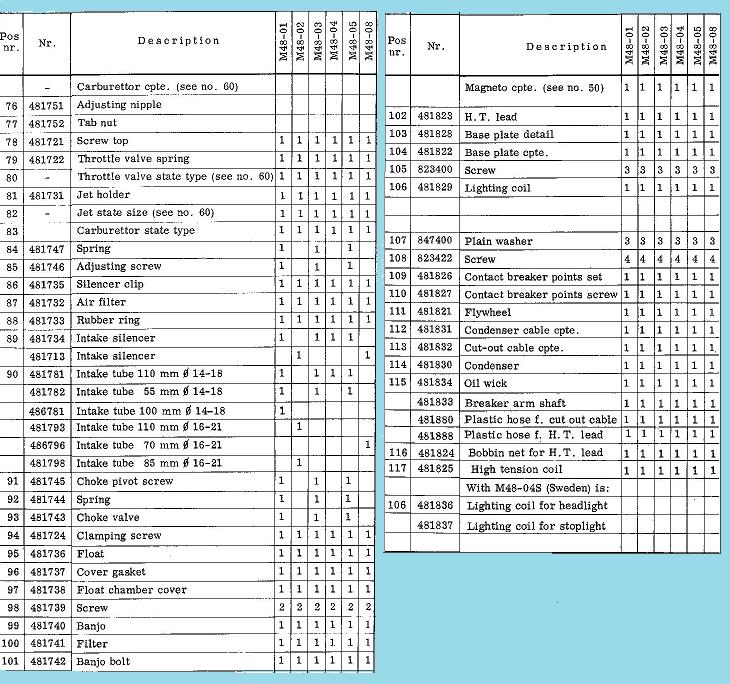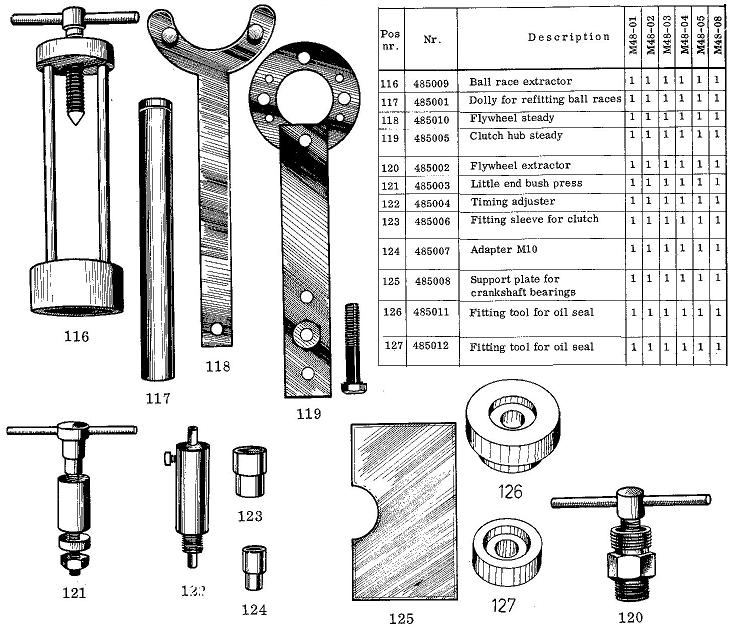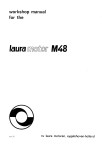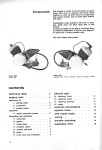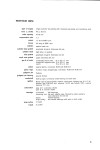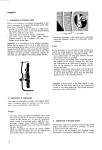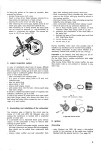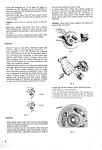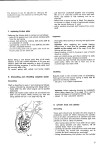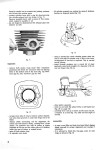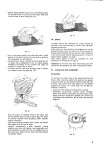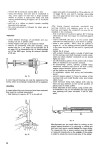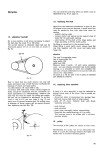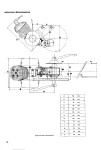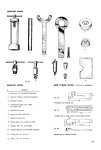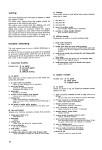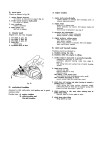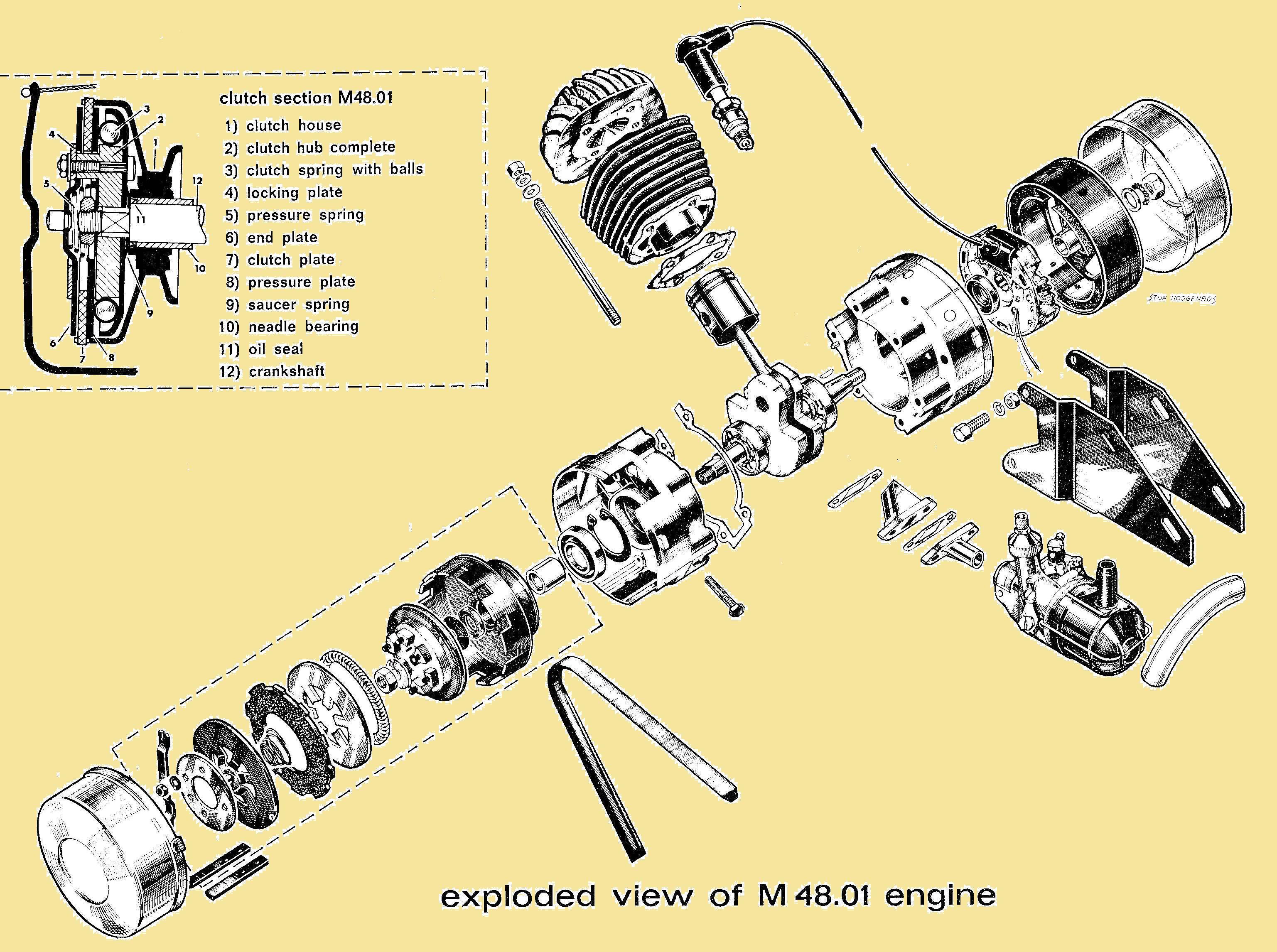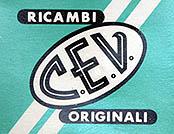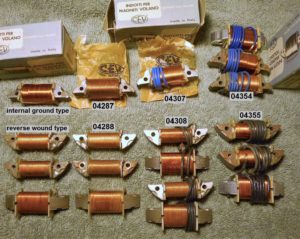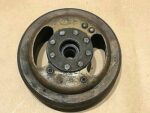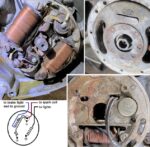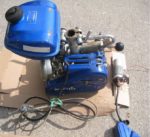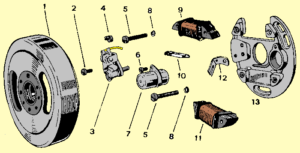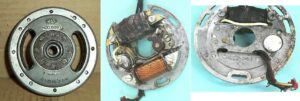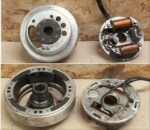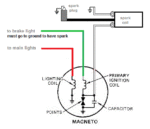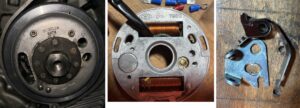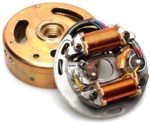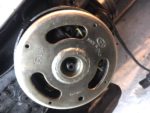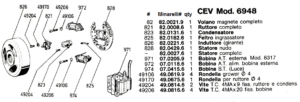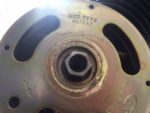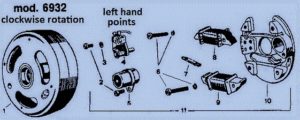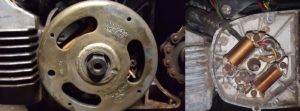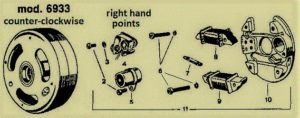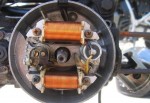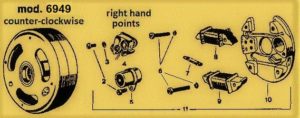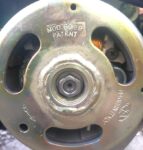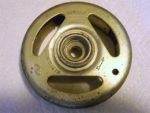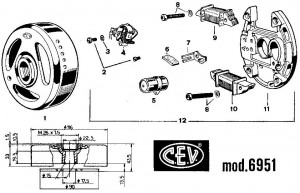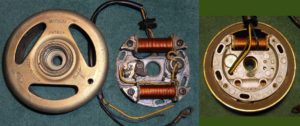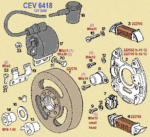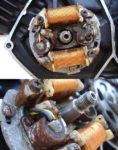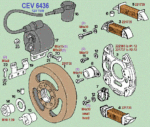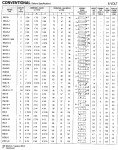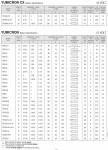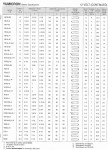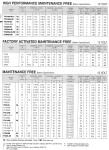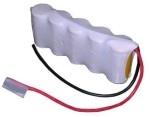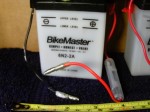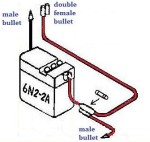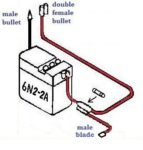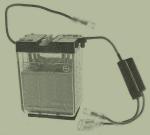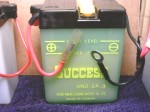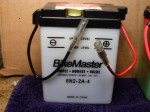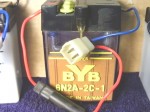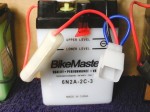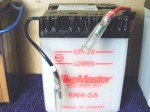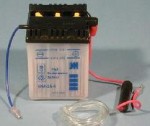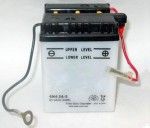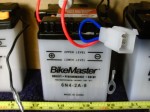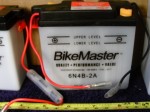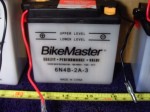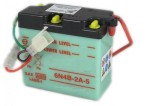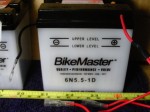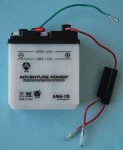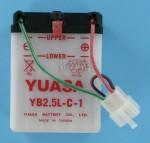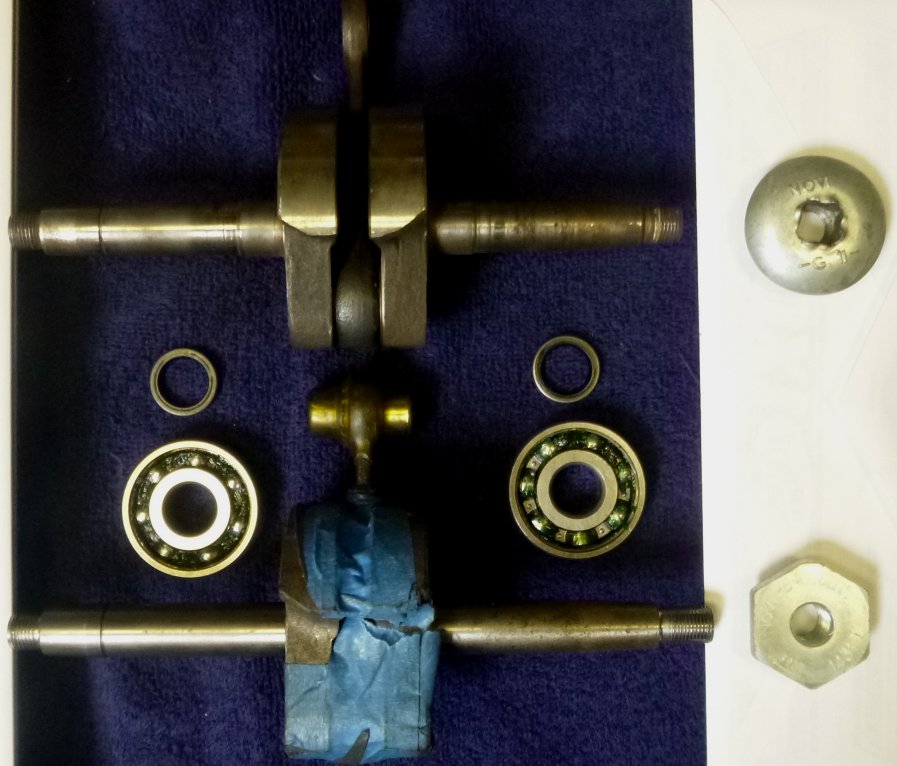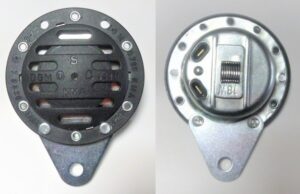 Contents
Contents
1. Parts by Type
2. Index and Identification
3. Parts for US-models with Aermacchi engines
4. Parts for US-models with Morini engines
5. Parts for EU-models with Morini engines
6. Parts for US-models with Benelli engines
7. Parts for EU-models with Benelli engines
8. Parts for EU-models with various engines
 1. Dansi Parts by Type
1. Dansi Parts by Type

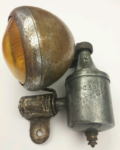
Armando Dansi and his company made bicycle generators and lights in Varese, Italy, since the 1930’s.
Dansi magneto generators (power dynamos) were on 1950’s to 1980’s Italian small motorcycles and mopeds, such as Aermacchi, Benelli, Cagiva, Fantic, Italjet, Lambretta, Lem, Malanca, Rizzato, Zannetti, and non-Italian brands such as Flandria, NSU and NVT.
On US-models 1960 to 1990, Dansi magnetos were original on mini-cycles and mopeds with engines by Aermacchi (Harley Davidson), Benelli (Benelli and Moto Guzzi) and Morini (Arciero, Baretta, Benvenuti, Beta, Bianchi, Cimatti, Cosmo, Colt, F. Morini, Fantic, Garelli, Intramotor-Gloria, Indian, Italjet, Italvelo, Italtelai, LEM, Malaguti, Motobecane Sebring, Negrini, NVT, Pacer, Scorpion, Snark, Spisni Lino, Velomec, West Wind).
Sources: Some Benelli part numbers are from original parts catalogs displayed on Benelli Bauer. Some are not listed in Benelli Bauer. They are from original parts catalogs and suppliers lists.
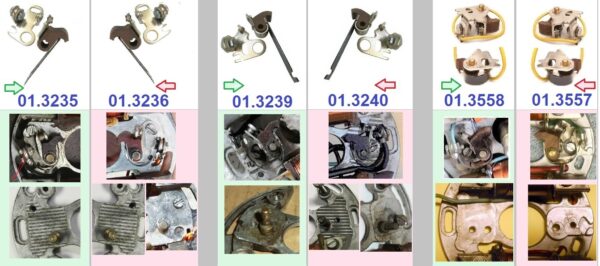
6 points (contacts) ruttori (contatti) and 8 stator plates (piatti statore)
Dansi Points
mm# sgr# rot M# Dansi# price 0 ’76-on 00000 70’s 000000 60’s
mm# sgr# rot M# Dansi# price 0 Benelli# 00 Benelli# 0000 Benelli#
1D 01.3235 ⇒M00 000000 $18.0 62.70.96.00? 000.000.0.000 SD5/B
1S 01.3236 ⇐M00 000000 $26.0 35.70.88.00 799.001.0.799 G221/4
2D 01.3239 ⇒M00 000000 $29.0 69.70.88.00 779.002.0.799 CS0004
2S 01.3240 ⇐M00 000000 none 70.70.88.20 000.000.0.000 M56/2
3D 01.3558 ⇒M18 408800 $16.0 48.70.88.70 779.014.0.799
3S 01.3557 ⇐M14 000000 $16.0

Dansi Condensers
sgr# rot. M# Dansi# price ’76-on 00000 70’s 00000 60’s
sgr# rot. M# Dansi# price Benelli# Benelli# Benelli#
type rot. capacitance size
00.0000 M00 000000 none 35.70.86.00 723.001.0.799 G221/6
∅18 flange type, 0.29mf ∅17.9 x 21 with wires use M17D
07.0074 M17D 403966 $15.0 48.70.86.70 723.002.0.799 G26/2
∅18 flange type, 0.29mf ∅17.9 x 21, no wires can use M17
07.0207 M17 000000 $13.0
∅18 flange type, 0.30mf ∅17.8 x 25, no wires
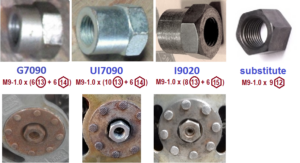
 Flywheel Nuts
Flywheel Nuts
price ’76-on 0000 70’s 00000 60’s 000 for
price Benelli# Benelli# Benelli# engines
none 00.00.00.00 264.025.0.799 G7090 GM
$00.0 flywheel nut M9-1.0 x 12, ∅13 x 6, hex14 x 6
$00.0 superseded by UI7090
$9.50 48.71.95.70 264.025.0.799 UI7090 G2
$00.0 flywheel nut M9-1.0 x 16, ∅13 x 10, hex14 x 6
none 92.75.00.73 264.004.0.799 I9020 FA, 4M
$00.0 flywheel nut M9-1.0 x 14, ∅13 x 8, hex14 x 6
$7.00 substitute for GM, G2, FA, 4M
$00.0 flywheel nut M9-1.0 x 9 hex 12 (uses a 12 socket)
none 35.06.72.70 000.000.0.799 00000 4M-1978
$00.0 flywheel nut not yet identified


Dansi Flywheel Pullers
fig# part# 0 price all have M19-1.00 thread unless noted
1. P19100 $18.0 flywheel puller M19-1.0 thread
2. P19x22 $19.0 flywheel puller M19-1.0 and M22-1.5
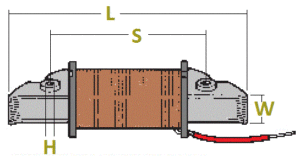
Dansi Coils
H S W L price Dansi# M# Benelli# 00 Benelli# 0000 Benelli#
H S W L for magneto#
Ignition Source Coils internal ground, one wire
4 46 00 00 none 0000 M00 00.00.00.00 713.001.0799 R3086/D
0 00 00 00 for ASL308NB (R3086) .
4 4? 00 00 none 0000 M00 00.00.00.00 713.009.0799 R2063/F
0 00 00 00 for (R2063) .
4 4? 00 00 none 0000 M00 00.00.00.00 713.008.0799
0 00 00 00 for (FA3774) .
4 47 12 72 $75.0 0000 M20 48.71.50.90
0 00 00 00 for 101441 (48.71.24.90) .
4 47 00 00 none 0000 M00 48.71.50.71
0 00 00 00 for 101662? .
4 47 14 72 none 6218 M00 SGR 00.1348
0 00 00 00 replacement .
Ignition Source Coils external ground, two wires
4 47 14 72 none 0000 M27 71.71.50.25
0 00 00 00 for 101732, 101765, 101813 .
Ignition Spark Coils
4 47 10 72 none 6400 M00 48.71.50.70 713.006.0799 N14/B
0 00 00 00 for 100892 (48.71.24.71), others .
4 47 10 72 none 6400 M00 SGR 00.1137
0 00 00 00 replacement .
000 D18 106 713.006.0.799 48.71.50.70 N/A N14/B (lower) internal spark coil B
Lighting Source Coils
4 46 00 00 none 0000 M00 00.00.00.00 000.000.0799 R3086/B
0 00 00 00 for ASL308NB (R3086) .
4 4? 00 00 none 0000 M00 00.00.00.00 713.010.0799 R2063/C
0 00 00 00 for ??????? (R2063) .
4 47 00 00 none 0000 M00 48.71.51.70 713.005.0799 N14/C
0 00 00 00 for ??????? (FA3774) .
4 47 00 00 none 0000 M00 48.71.51.70 713.005.0799 N14/C
0 00 00 00 for MDP44? .
4 47 15 72 $65.0 6533 M21 48.71.51.90
0 00 00 00 for 101441 6V 25/10w .
4 47 00 00 none 0000 M00 48.71.51.70
0 00 00 00 for ??????? 6V18w? .
4 47 00 00 none 0000 M00 48.71.51.71
0 00 00 00 for 101662? 6V25w? .
4 47 15 72 $65.0 0000 M28 71.71.51.25
0 00 00 00 for 101813 6V25w .
Hardware
Dansi# M# 0 Benelli# 0000 Benelli# 00 price 0 Benelli# .
000000 M00 742.005.0.799 48.70.95.70 N/A G221/11
000000 M00 felt greaser
000000 M15 793.007.0.799 35.70.79.00 $2.50 G221/3
000000 M00 points screw M4x8 small head
000000 M16 793.007.0.799 35.70.79.00 $0.20 G221/3
000000 M00 points screw lock washer M4 x 9 x 1
000000 M00 793.008.0.799 00.00.00.00 $0.00 R2063/E
000000 M00 ignition coil screw M5
000000 M22 776.013.0.799 70.71.89.20 $0.40 G221/8
000000 M00 coil lock washer M4 x 7 thin
000000 M25 793.041.0.799 35.71.57.50 $1.20 G221/7
000000 M00 coil screw M4 x 25 slot
000000 M00 000.000.0.000 48.71.57.50 $1.60 G0000
000000 M00 coil screw and washer M4 x 25
000000 M00 783.006.0.799 48.71.57.70 N/A SD404/1
000000 M00 screws and washers
 2. Index and Identification
2. Index and Identification
Look up your magneto number to see what section the parts are in.
D<<rotation o.d plate years in section
ADL54? 000 110 1Da 60-66 6. US Benelli
ADL54/ANB 110 1Da 65-68 6. US Benelli
ADL60 000 110 1Da 60-63 8. EU various
ADL2S 000 110 2Db 60-67 8. EU various
ADL250B 0 110 2Dc 00-00 8. EU various
ADP44 000 110 2Dc 62-72 7. EU Benelli
ADP79AN 0 110 000 67-67 7. EU Benelli
ADL8 0000 110 2Db 00-00 8. EU various
MDL102 00 110? 2De 00-00 8. EU various
MDL111 00 110 2Dd 70-73 4. US Morini
ADP220VS fan 2Dd 65-67 6. US Benelli
ADP244S 0 110 2Dd 69-73 6. US Benelli
MDP44 000 110 2Dd 67-73 7. EU Benelli
100892 D 110 2Dd 70-74 7. EU Benelli
100884 D 103 3Db 78-80 7. EU Benelli
101441 D 103 3Db 76-77 6. US Benelli
101662 D 103 3Db 74-84 7. EU Benelli
101813 D 103 3Db 77-80 6. US Benelli
S >>rotation o.d plate years in section
ASL111 110 2Sc 67-70 8. EU various
ASL123V fan 2Sd lt. 60s 4. US Morini
ASL204NS 110 1Sb 67-73 6. US Benelli G314
ASL234NS 110 1Sb 73-74 3. US Aermacchi
ASL251S 0 110 1Sb 00-00 3. US Aermacchi
ASL5N 000 110 1Sc 60-68 6. US Benelli
ASL6? 000 110? 1Sc 00-00 5. EU Morini
ASL205NS 110 1Sc 65-75 6. US Benelli
ASL206S? 0 110? 1Sc 71-72 4. US Morini
ASL233S 0 110 1Sc 71-72 4. US Morini
ASL233NS 110 1Sc 71-72 4. US Morini
ASL308NB 103 1Sc 73-76 6. US Benelli
ASL314B 0 103 1Sc 73-74 7. EU Benelli
ASL236NS 110 2Sc 00-00 3. US Aermacchi
ASL237 00 110 2Sc 72-72 3. US Aermacchi
MSL105 00 110 2Sc 74-80 7. EU Benelli
ASL207? 0 110 2Sd 65-66 6. US Benelli
ASL222S 0 110 2Sd 64-66 3. US Aermacchi
ASL223VS fan 2Sd 66-69 4. US Morini
ASL232S 0 110 2Sd 70-72 6. US Benelli
MSL111 00 110 2Sd 00-00 5. EU Morini
101286 S 103 3Sc 75-79 4. US Morini
101603 S 103 3Sc 00-00 5. EU Morini
101732 S 103 3Sc 75-77 4. US Morini
101765 S 103 3Sc 76-80 4. US Morini
102690 S 103 3Sc 00-00 5. EU Morini
Stator Plate Versions with links to photos
mm# o.d. slots slots points under upper lower
mm# o.d. slots type points points 0 coil 00 coil Dansi#
1Da ∅94 2+3 plain 5 xx 1D smooth 4 x 46? 4 x 46?
000 Benelli SD6 .
1Sb ∅94 2+3 stepped 4 1S ribbed 4 x 46? 4 x 46?
000 Benelli G221/1, Aermacchi .
1Sc ∅94 2+3 stepped 4 1S smooth 5 x 43 4 x 46 3842
000 Benelli R2063/B = 772.001.0.799, Morini .
2Db ∅94 2+3 stepped 4 2D smooth 4 x 47 4 x 47
000 various .
2Dc ∅94 2+3 stepped 4 2D ribbed 4 x 47 4 x 47
000 Benelli, various .
2Sc ∅94 2+3 stepped 4 2S ribbed 4 x 47 4 x 47
000 Aermacchi .
2Dd ∅94 2+3 long step 4 2D smooth 4 x 47 4 x 47
000 Benelli SD462/3 = 772.006.0.799 G2,GM, Morini
2Sd ∅94 2+3 long step 4 2S smooth 4 x 47 4 x 47 2 versions
000 Benelli M56/1, Aermacchi 29549-65PA, Morini .
2De ∅80 2 plain 4 xx 2D smooth 4 x 47 4 x 47
000 various .
3Db ∅94 2+3 stepped 4 3D smooth 4 x 47 4 x 47
000 Benelli 69.70.22.07 G2 .
3Sc ∅80 2 plain 4 xx 3S smooth 4 x 47 4 x 47
000 Morini mmi# M44 and M44A .
This identification data is from measurement of actual plates and from internet images. Only the older “1” type plates have Dansi numbers. The others have no markings. So here we use mm numbers with encoded digits. Digits 1 and 2 encode the points. Digit 3 encodes the outer diameter and mounting slots. Knowing the plate identity helps to identify the points and coils, and visa versa.
 Magnetos
Magnetos
eng Benelli# 000 Benelli# 0000 Benelli# magneto#.
FA 00.00.00.00 000.000.0799 G221 0 ASL205NS .
FA 70.71.24.00 000.000.0799 G7094 0 MSL105? Export FA .
3VK 00.00.00.00 000.000.0799 G221 0 ASL205NS .
3VK 00.00.00.00 000.000.0799 000000 ADP220VS .
3VK 70.71.16.20 000.000.0799 000000 100884 ’78 3VK-NT .
3VK 70.71.24.00 000.000.0799 G7094 0 MSL105? Export FA 1976 .
4M 00.00.00.00 000.000.0799 G314 0 ASL204NS .
4M 00.00.00.00 427.016.0799 R2063 ??????? ’70’s Turismo .
4M 35.71.24.00 000.000.0799 000000 ??????? ’78 Turismo .
4MS 00.00.00.00 000.000.0799 G26 00 ASL5N
4MS 00.00.00.00 000.000.0799 G221 0 ASL205NS .
GM 00.00.00.00 427.022.0799 FA3774 ??????? G.man, Motorella .
GM, G2 00.00.00 427.005.0799 N14 0 MDP44 ’67-73 Gentleman, Bobo .
G2 48.71.24.71 427.027.0799 N14 0 100892 ’70-75 Bobo, Guzzi Chiu .
G2 48.71.24.72 000.000.0799 000000 101662 G.man 2, ’78-G2, G2 Elle .
G2 48.71.24.90 000.000.0799 000000 101441 G2-US .
G2 69.71.24.15 000.000.0799 000000 ??????? Gentleman 1974 .
G2 71.71.24.25 000.000.0799 000000 101813 G2-US .
GK 00.00.00.00 000.000.0799 N134 0 ADP244S .
90 00.00.00.00 000.000.0799 R3086 ASL308MB
125 00.00.00.00 000.000.0799 M56 00 ASL207?
125 00.00.00.00 000.000.0799 M246 0 ??????? ’65-69 Cobra 125 .
175 00.00.00.00 000.000.0799 M375 0 ASL232S .
250 00.00.00.00 000.000.0799 SD596 ADL54?
250 00.00.00.00 000.000.0799 SD595 ADL54/ANB .
00 00.00.00.00 000.000.0799 000000
 3. US models with Aermacchi engines
3. US models with Aermacchi engines

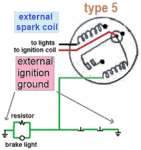
ASL222S ∅82 x 110 alum. rotor, ∅94 3+2 long-slot stator
⇐rotation Sinistra, M19-1 puller, type 5
’65-66 Harley Davidson M50, MS50
29529-65P none points 01.3240 M56/2
32726-65P $15.0 condenser 07.0074 M17D
11212P-00 $0.00 woodruff key 2.5?
29595-65P none flywheel nut M9-1.0
29595-65P $7.00 substitute M9-1.0 x 9 hex12
29549-65PA none base plate ⇐ 3+2 long-slot = Benelli M56/1


ASL234NS ∅82 x 110 aluminum rotor, ∅94 3+2 slot stator
⇐rotation Sinistra, puller M19-1, type 5
’73-74 Harley Davidson X-90, Z-90
$26.0 points 01.3236
$15.0 condenser 07.0074 = M17D
none base plate ⇐ 3+2 slot = Benelli G221/1


ASL236NS ∅82 x 110 aluminum rotor, ∅94 3+2 slot stator
⇐rotation Sinistra, M19-1 puller, type 5
’70-73 Harley Davidson ML65 Leggero
29529-65P none points 01.3240 M56/2
32726-65P $15.0 condenser 07.0074 M17D
11212P-00 $0.00 woodruff key 2.5?
29595-65P none flywheel nut M9-1.0
29595-65P $7.00 substitute M9-1.0 x 9 hex12
29549-65PA none base plate ⇐ 3+2 slot
29549-65PA none long slots got shorter but # stayed the same


ASL237 ∅82 x 110 aluminum rotor, ∅94 3+2 slot stator
⇐rotation Sinistra, puller M19-1, type 5
’72 Harley Davidson Rapido 125
29529-65P none points 01.3240 M56/2
32726-65P $15.0 condenser 07.0074 = M17D

ASL251S ∅82 x 110 aluminum rotor, ∅94 3+2 slot stator
⇐rotation Sinistra, puller M19-1, type 5
’70’s Harley Davidson
000 none points 01.3240 M56/2
000 $15.0 condenser 07.0074 = M17D
 4. US models with Morini engines
4. US models with Morini engines


ASL123V ∅82 x fan alum. rotor, ∅94 3+2 long-slot stator
⇐rotation Sinistra, M19-1 puller, type 5
’60’s mini cycle with Morini 4MP engine
none points 01.3240 = M56/2
$15.0 condenser 07.0074 = M17D
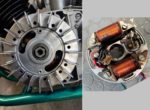

ASL223VS ∅82 x fan alum. rotor, ∅94 3+2 long-slot stator
⇐rotation Sinistra, M19-1 puller, type 5
’66-69 Chris Cycle (Wilier) M2, M2V with Morini 3CV engine
none points 01.3240 = M56/2
$15.0 condenser 07.0074 = M17D

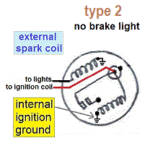
ASL233S ∅82 x 110 aluminum rotor, ∅94 3+2 slot stator
⇐rotation Sinistra, M19-1 puller, type 2
’71-72 Indian MX100, Motorsport 100 off-road, Morini 101 engine
ASL206 none magneto ASL233S
ASL6/1 none rotor (flywheel)
ASL6/2 none base plate
ASL6/4 none lights coil
ASL6/6 $26.0 points 01.3236 = G221/4
ASL6/10 $15.0 condenser 07.0074 = M17D
ASL6/18 none ignition source coil (internally grounded)
12.7005 $0.00 flywheel key
13.3002 $0.00 flywheel nut
Link to Indian Dirt Bike Parts Manuals
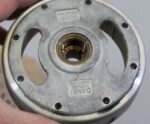

ASL233NS ∅82 x 110 aluminum rotor, ∅94 3+2 slot stator
⇐rotation Sinistra, M19-1 puller, type 5
’71-72 Indian Bobcat on-road mini-cycle, Morini 101 engine
ASL206/SC none magneto ASL233NS
ASL6/1 000 none rotor (flywheel)
ASL6/2 000 none base plate
ASL6/4 000 none lights coil
ASL6/6 000 $26.0 points 01.3236 = G221/4
ASL6/10 00 $15.0 condenser 07.0074 = M17D
ASL6/18B 0 none ignition source coil with ground wire
12.7005 00 $0.00 flywheel key
13.3002 00 $0.00 flywheel nut


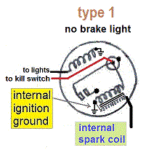
MDL111 ∅82 x 110 aluminum rotor, ∅94 3+2 long-slot stator
⇒rotation Destra, puller M19-1, Morini 29.0006, type 1
’70-73 Indian (Italjet) MM5A, JC5A Morini S5K, S5K2 engine
and ’70’s EU models with Morini F5M2, M4 engine
MDL111/6 $29.0points 01.3239
MDL111/10 $15.0 condenser 07.0074 = M17D
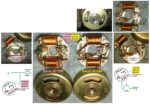

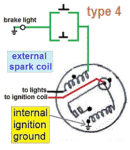
101286 ∅82 x 103 steel rotor, ∅80 2 slot stator
⇐rotation Sinistra, M19-1 puller, Morini 29-0034, type 4
’75-77 Intramotor-Gloria Morini MO1 engine
’76-79 NVT, Malaguti Morini MO1, MO2 engine
’76-79 Pacer Sport (some), others Morini MO1, MO2 engine
M# qty price description
M14 1 $16.0 points CEV-type for left rotation
M15 2 $2.50 screw for points & cond. M4 x 8 small head
M16 1 $0.20 lock washer for points screw Ø4 x 9 x 1
M17 1 $15.0 condenser M17D
M22 5 $0.40 thin lock washer for cond. & coil screws Ø4
M00 2 $1.00 29-6022 stator plate screws M4 x 12 phillips
M12 1 N/A felt wiper, early type
M20 1 $75.0 ignition coil up. 47-12-72 1 short cond. wire
M21 1 $65.0 lighting coil lo. 47-15-72 long grn, long blk
M24 2 $0.50 ignition coil screw M4 x 20 slot
M25 2 $0.50 lighting coil screw M4 x 25 slot
M26 1 N/A steel flywheel, says 101286 ( same as 101765)
M44 1 N/A stator plate with cut-out for spark coil
M45 1 $190. stator assembly OD ∅80, slots ∅65, at 9 & 3 o’clock
M83 1 $6.00 woodruff key M83 12-7025 2.5 x 9 (x 3)
M00 1 none 29-0034 magneto 101286 = M26 + M45
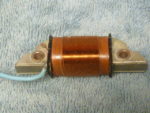
M20 ignition coil
for Dansi 101286
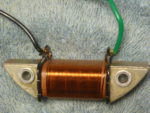
M21 lighting coil
for Dansi 101286



101765 ∅82 x 103 steel rotor, ∅80 2 slot stator
⇐rotation Sinistra, M19-1 puller, Morini 29-0045, type 5
’76-85 Motomarina, Scorpion Morini MO1, MO2 engine
’77-80 Motobecane Sebring Morini MO1, MO2 engine
’76-80 Pacer (some), others Morini MO1, MO2, M1, MO4B engine
M# qty price description
M14 1 $16.0 points CEV-type for left rotation
M15 2 $2.50 screw for points & cond. M4 x 8 small head
M16 1 $0.20 lock washer for points screw Ø4 x 9 x 1
M17 1 $15.0 condenser M17D
M22 5 $0.40 thin lock washer for cond. & coil screws Ø4
M00 2 $1.00 29-6022 stator plate screws M4 x 12 phillips
M12A 1 N/A felt wiper, late type
M25A 4 $0.50 ign and light coil screw M4 x 25 phillips
M26A 1 $150. steel flywheel, says 101765 (=101286)
M27 1 none ignition coil up. 47-14-72 long grn, to cond.
M28 1 $65.0 lighting coil lo. 47-15-72 long black wire
M44A 1 N/A stator plate, no cut-out for spark coil
M45A 1 $200. stator assembly OD ∅80, slots ∅65, at 9 & 3 o’clock
M83 1 $6.00 woodruff key M83 12-7025 2.5 x 9 (x 3)
M00 1 $330. 29-0045 magneto 101765 = M26A + M45A
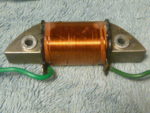
M27 ignition coil
for Dansi 101765
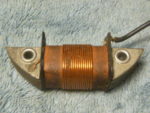
M28 lighting coil
for Dansi 101765



101732 ∅82 x 103 steel rotor, ∅80 2 slot stator
⇐rotation Sinistra, M19-1 puller, Morini 29-0045, type 5
superseded in early 1977 by 101765
’75-77 Intramotor-Gloria (some), others, Morini MO1 engine
M# qty price description
M14 1 $16.0 points CEV-type for left rotation
M15 2 $2.50 screw for points & cond. M4 x 8 small head
M16 1 $0.20 lock washer for points screw Ø4 x 9 x 1
M17 1 $15.0 condenser M17D
M22 5 $0.40 thin lock washer for cond. & coil screws Ø4
M00 2 $1.00 29-6022 stator plate screws M4 x 12 phillips
M12 1 N/A felt wiper, early type
M25 4 $0.50 ignition and lighting coil screw M4 x 25 slot
M26A 1 N/A steel flywheel, says 101732 (same as 101286)
M27 1 none ignition source coil (upper) 47-14-72 1 long green, 1 to condenser
M28 1 $65.0 lighting source coil (lower) 47-15-72 1 long black wire
M44 1 N/A stator plate, early (same but with cut-out, for internal spark coil)
M45A 1 N/A stator assembly OD ∅80, slots ∅65, at 9 & 3 o’clock
M83 1 $6.00 woodruff key M83 12-7025 2.5 x 9 (x 3)
M27 coil: Because the service manuals did not mention the “external ignition ground” troubleshooting procedure, where you ground the green wire to get spark, many people have replaced the coils, both the internal M27 ignition source coil and the external spark coil (transformer), when they did not need them. As a result, the supply of M27 source coils has ran out.
M44 plate: The M44 stator plate bare (for 101286) and the M44A (for 101765) have different part numbers and different felt wipers, but they do interchange. The M44A has no cut-out for a internal transformer spark coil, and so is a later design. The M44A is made stronger.
On a moped with a Morini engine, the number on the Dansi flywheel tells 1) what magneto it has, external (101765 or 101732) or internal (101286) ignition ground, 2) what brake light wiring the bike has, series brake light switches (9342 normally closed) in parallel with the light for 101765 or 101732, or parallel brake light switches (9343 normally open) in series with the light for 101286, 3) what CEV 9530 tail light version it has, one with a brake light resistor hidden inside (101765 or 101732), or with no resistor (101286).This matters a lot when troubleshooting a bike that has no spark. Bikes with external ignition ground often loose spark because of a loose brake light wire. On those you always ground (connect to the frame) the green magneto wire first, and then re-check for spark. That way you will know if the problem is external, in the bikes wires and lights, or internal in the magneto, such as dirty points.
 5. EU models with Morini engines
5. EU models with Morini engines
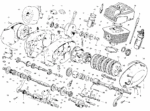

ASL6? ∅82 x 110? aluminum rotor, ∅94 3+2 slot stator
⇐rotation Sinistra, M19-1 puller, type 1
various models off-road with Morini 101 engine
Morini# price
29-0022 none magneto without B.A.T.E.
= without bobina alta tension esterna (external high tension coil)
ASL6/2 none base plate
ASL6/3 none internal spark (high tension) coil
ASL6/4 none lights coil
ASL6/6 $26.0 points 01.3236 = G221/4
ASL6/10 $15.0 condenser 07.0074 = M17D
12.7005 $0.00 flywheel key
13.3002 $0.00 flywheel nut

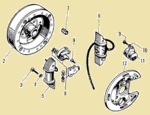
MSL111 ∅82 x 110 aluminum rotor, ∅94 3+2 slot stator
⇐rotation Sinistra, M19-1 puller, type 1
’60’s models with Morini M4 engine
none points xxx 01.3240 = M56/2
$15.0 condenser 07.0074 = M17D


102690 ∅82 ∅103 steel rotor, ∅80 2 slot stator
⇐rotation Sinistra, M19-1 puller, type 2
1980’s models with Morini M1K engine
$16.0 points xxx 01.3557 = M14
$15.0 condenser 07.0074 = M17D


101603 ∅82 x 103 steel rotor, ∅94 3+2 slot stator
⇐rotation Sinistra, M19-1 puller, Morini 29.0045, type 2
70’s-80’s models with Morini M4? engine
$16.0 points xxx 01.3557 = M14
$15.0 condenser 07.0074 = M17D
 6. US models with Benelli engines
6. US models with Benelli engines
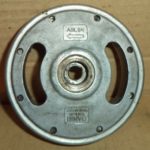
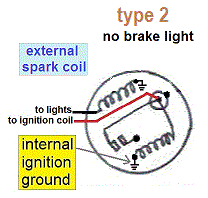
ASL5N ∅82 x 110 aluminum rotor, ∅94 3+2 slot stator
⇐rotation Sinistra, M19-1 puller, type 2
1965-68 Benelli Fireball 50 with Benelli 4MS engine
106 none G26 magneto ASL5N
110 $0.00 I 9020 flywheel nut
099 $2.00 G7274 woodruff key #M81 2.0 x 3.7
193 none G221/1 base plate
196 $26.0 G221/4 points 01.3236
194 none G26/1 ignition coil
195 none G26/3 lights coil
198 $15.0 G26/2 condenser 07.0074 M17D


ASL205NS ∅82 x 110 aluminum rotor, ∅94 3+2 slot stator
⇐rotation Sinistra, M19-1 puller, type 5
1965-66 Riverside 450 SS Sport 50 with Benelli 4MS engine
1965-68 Riverside Moped with Benelli FA engine
1974-75 Benelli 3V, 3VK with Benelli 3V, 3VK engine
106 none G221 magneto ASL205NS
110 $0.00 I 9020 flywheel lock nut
099 $2.00 G7274 woodruff key #M81 2.0 x 3.7
193 none G221/1 base plate
196 $26.0 G221/4 points 01.3236
194 none G221/2 ignition coil
201 none G221/9 lights coil
198 $15.0 G221/6 condenser 07.0074 M17D


ASL20 ∅82 x 110 aluminum rotor, ∅94 3+2 long-slot stator
⇐rotation Sinistra, M19-1 puller, type 2
1967-68 Riverside Lightweight 175, 1967 Scrambler 175


ASL207? ∅82 x 110 aluminum rotor, ∅94 3+2 long-slot stator
⇐rotation Sinistra, M19-1 puller, type 2
1965 Riverside Touring 125, 1966 Scrambler 125
156 none M56 magneto
158 $0.00 M58 flywheel nut
144 $2.00 G7274 woodruff key #M81 2.0 x 3.7
178 none M56/1 base plate
181 none M56/2 points
182 none M56/3 ignition coil
182 none M56/4 lights coil, green and black wires
187 $15.0 G221/6 condenser M17D

ASL??? ∅82 x 110? aluminum rotor, ∅94 3+2 slot stator
⇐rotation Sinistra, M19-1 puller, type 5
1965-69 Ward Riverside 125 Lightweight
1965-69 Benelli Cobra 125, 1966-71 Cobra 125 Trail
156 none M246 magneto
158 $0.00 M58 flywheel nut
099 $2.00 G7274 woodruff key #M81 2.0 x 3.7
178 none M56/1 base plate
181 none M56/2 points
182 none M56/3 ignition coil
182 none M246/B lights coil
187 $15.0 G221/6 condenser


ADP220VS ∅82 x fan aluminum rotor, ∅94 3+2 long-slot stator
⇒rotation Destra, M19-1 puller, type 5
1965-67 Riverside Scooter 350-S with Benelli 3V engine
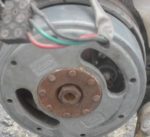

ADP244S ∅82 x 110 aluminum rotor, ∅94 3+2 slot stator
⇒rotation Destra, M19-1 puller, type 5
1969-69 Benelli Buzzer, Hornet GK engine
1970-73 Benelli Buzzer 65, 1970-72 Buzzer 65 Jr GK65 engine
1971-72 Benelli Hurricane 65 GK65 engine
072 none N134 magneto ADP244S
069 $0.00 G7090 flywheel nut
076 $2.00 G7274 woodruff key #M81 2.0 x 3.7
161 none SD426/3 base plate
158 $29.0 CS 0004 points 01.3239
153 none G221/2 spark coil
153 none G314/A lights coil
159 $15.0 G221/6 condenser


ADL54/ANB ∅82 x 110 aluminum rotor, ∅94 3+2 slot stator
⇒rotation Destra, machined flywheel, Benelli SD595, type 5
1965-68 Benelli Sprite 125 OHV engine
$18.0 points 01.3235 = SD5/B
$15.0 condenser 07.0074 = M17D = 1984/F

ADL54? ∅82 x 110 aluminum rotor, ∅94 3+2 slot stator
⇒rotation Destra, machined flywheel?, Benelli SD596, type 5
1965-68 Benelli Sprite 200, 250 OHV engine
1967-68 Benelli Barracuda 250 OHV engine
$18.0 points 01.3235 = SD5/B
$15.0 condenser 07.0074 = M17D = 1984/F


ASL204NS ∅82 ∅110 aluminum rotor, ∅94 3+2 slot stator
⇐rotation Sinistra, M19-1 puller, type 5
1967-69 Benelli Dynamo 50 Compact, 1969 Dynamo 50 Trail (69) 4M
1970-71 Benelli Dynamo 65 Compact, Woodsbike, Scrambler (71) 4M65
1972-72 Benelli Dynamo 65 Compact, Woodsbike, Scrambler (72) 4M65
1970-72 Benelli Cougar 65 (71-on)
1970-73 Benelli Mini Enduro 65
106 none G314 magneto ASL204NS
110 $0.00 G7090 flywheel nut
110 $0.00 I 9020 flywheel nut (Dynamo 50 only)
099 $2.00 G7274 woodruff key #M81 2.0 x 3.7
193 none G221/1 base plate
196 $26.0 G221/4 points 01.3236
194 none G221/2 ignition coil
194 none G314/A lights coil
198 $15.0 G221/6 condenser 07.0074 M17D
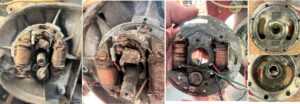

ASL232S ∅82 x 110 aluminum rotor, ∅94 3+2 slot stator
⇐rotation Sinistra, M19-1 puller, type 5
1970-72 Benelli Volcano 180
148 none M375 magneto ASL232S
150 $0.00 M58 flywheel nut M10?
136 $2.00 G7274 woodruff key #M81 2.0 x 3.7
206 none M56/1 base plate
208 none M56/2 points 01.3240
209 none M375/C ignition coil
209 none M375/B lights coil
203 $15.0 G221/6 condenser 07.0074


ASL308NB ∅82 x 103 steel rotor, ∅94 3+2 slot stator
⇒rotation Destra, M19-1 puller, type 4
1973-76 Benelli Banshee 90 with 90 single
1973-74 Benelli Panther 125 with 125 single
116 none 000.000.0799 R3086 magneto ASL308NB
114 $0.00 264.004.0799 I 9020 flywheel nut
121 $2.00 958.006.0799 G7274 woodruff key #M81 2.0 x 3.7
198 none 772.001.0799 R2063/B base plate
202 $26.0 799.001.0799 G221/4 points 01.3236
203 none 000.000.0799 R3086/B coil
203 none 713.001.0799 R3086/D coil
200 $15.0 723.001.0799 G221/6 condenser M17D



101441 ∅82 x 103 steel rotor, ∅94 3+2 slot stator
⇒rotation Destra, M19-1 puller, type 4
1976-77 Benelli Blazer with Benelli G2 engine
1976-77 Moto Guzzi Robin, Chiu with Benelli G2 engine
000 48.71.24.90 M00 none magneto 101441
074 35.70.79.00 M00 $9.50 UI7090 flywheel nut M9-1.0 x 16
074 35.70.79.00 M00 $00.0 ∅13 x 10 inside, hex14 x 6 outside
102 69.70.22.07 M00 none stator plate for 1-piece CEV-left points
103 40.70.95.70 M00 none G221/11 felt wiper/greaser
104 35.70.79.00 M15 $2.50 G221/3 points & condenser screw
104 35.70.79.00 M15 $00.0 M4 x 8 small head, replacement
105 35.70.86.00 M17D$15.0 G221/6 condenser M17D
106 48.71.50.90 M20 $75.0 ignition source coil (lower) 1 short wire
107 48.70.88.70 M18 $16.0 points, 1-piece CEV-left-hand type
108 48.71.51.90 M21 $65.0 lights coil 6V 15/10w (upper) grn, blk
109 70.71.89.20 M22 $0.20 G221/8 thin lock washer ∅4 x 7 x 0.5
110 35.71.57.50 M25 $0.50 G221/7 coil screw M4 x 25 slot
111 48.71.16.81 M00 none steel flywheel, says 101441
112 48.71.57.70 M00 none SD404/1 screws and washers kit
113 98.20.04.10 M00 $0.70 stator plate screw M4 x 12 slot
Benelli Blazer was the USA version of the Benelli Bobo.
Moto Guzzi Robin (sheet frame) was the USA version of the Moto Guzzi Chiu. The Moto Guzzi Robin (monotube frame) was the same as the Benelli G2. The Moto Guzzi Robin with stamped sheet-metal frame had either a Dansi 101813 external ignition ground magneto, or a Dansi 101441 internal ignition ground magneto. The blue one above with 101441 had normally open brake light switches connected in parallel, so the brake light did not get power until either switch was closed. If the green wire became disconnect, the engine would still run.
The late 1970’s Dansi steel magneto flywheels for Benelli look like the late 1970’s Morini ones, but the rotation is opposite, clockwise and the stator plate is very different. The stator plate has 5 mounting slots, not two, and is larger. The stator plate has two upper mount screws and one lower. The upper lighting coil is notched for the screw installation. The lower ignition coil is not notched.




101813 ∅82 x 103 steel rotor, ∅94 3+2 slot stator
⇒rotation Destra, M19-1 puller, type 5
1977-80 Benelli G2 with Benelli G2 engine
1977-80 Moto Guzzi Robin with Benelli G2 engine
000 71.71.24.25 M00 none magneto 101813
074 35.70.79.00 M00 $9.50 UI7090 flywheel nut M9-1.0 x 16
074 35.70.79.00 M00 $00.0 ∅13 x 10 inside, hex14 x 6 outside
102 69.70.22.07 M00 none stator plate
103 40.70.95.70 M00 none G221/11 felt wiper/greaser
104 35.70.79.00 M15 $2.50 G221/3 points & condenser screw
104 35.70.79.00 M15 $00.0 M4 x 8 small head, replacement
105 35.70.86.00 M17D$15.0 G221/6 condenser M17D
106 71.71.50.25 M27 none ign. source coil (lower) grn, short
107 48.70.88.70 M18 $16.0 points M18
108 71.71.51.25 M28 $65.0 lights coil 6V 25w (upper) 1 black
109 70.71.89.20 M22 $0.20 G221/8 thin lock washer ∅4 x 7 x 0.5
110 35.71.57.50 M25 $0.50 G221/7 coil screw M4 x 25 slot
111 71.71.21.25 M00 none steel flywheel, says 101813
112 48.71.57.70 M00 none SD404/1 screws and washers kit
113 98.20.04.10 M00 $0.70 stator plate screw M4 x 12 slot
Moto Guzzi Robin (sheet frame) was the USA version of the Moto Guzzi Chiu. The Moto Guzzi Robin (monotube frame) was the same as the Benelli G2. The Moto Guzzi Robin with stamped sheet-metal frame had either a Dansi 101813 external ignition ground magneto, or a Dansi 101441 internal ignition ground magneto. The orange one above with 101813 had normally closed brake light switches connected in series, so the brake light was normally shorted out, until either switch was opened. If the green wire became disconnected, like when the brake light wires were unplugged, the engine would not run.
External ignition ground: On a 101813 the ignition coil has an external ground, the green wire. It must always be grounded in order to have spark. The green wire powers the brake light. Normally the brake light switches are closed, taking all the electricity from the brake light. Opening either brake light switch causes the brake light to go on, opposite to all normal light switches. Normal light switches close to make the light go on. Think of it like turning off your shower, by turning on the garden hose.
 7. EU models with Benelli engines
7. EU models with Benelli engines


100892 ∅82 x 110 aluminum rotor, ∅94 3+2 slot stator
⇒rotation Destra, M19-1 puller, type 1
1970-74? Benelli Bobo with Benelli G2 engine
071 none 427.027.0799 N14 magneto 100892 ?
074 $9.50 264.025.0799 UI7090 flywheel nut M9-1.0 x 16
074 $00.0 ∅13 x 10 inside, hex14 x 6 outside wheel
061 $2.00 958.006.0143 G7274 woodruff key
102 none 772.006.0799 SD462/3 base plate
103 none 742.005.0799 G221/11 felt greaser
104 none 793.007.0799 G221/3 points screw M4 x 8 small slot
104 $2.50 793.007.0799 replacement M4 x 8 small phillips
105 $15.0 000.000.0000 G26/2 condenser M17D
106 none 713.006.0799 N14/B spark coil
107 $29.0 000.000.0000 CS0004 points 01.3239
108 none 713.005.0799 N14/C lights coil
109 $0.20 776.013.0799 G221/8 lock washer ∅4 thin
110 $0.50 793.041.0799 G221/7 coil screw M4 x 25(23) slot
111 none 780.003.0799 N14/A flywheel rotor Bobo
112 none 783.006.0799 SD404/1 screws and washers
113 none 983.042.0125 MU1147 stator plate screw M4 x 10 slot
113 $1.20 983.042.0125 MU1147 replacement M4 x 10 phillips



MDP44 ∅82 x 110 aluminum rotor, ∅94 3+2 slot stator
⇒rotation Destra, M19-1 puller, type 1
1967-70? Benelli Gentlemen with Benelli GM engine
1970-73? Benelli Bobo 1 with Benelli G2 engine
1970-73? Benelli Bobo 2 with Benelli G2 engine
071 none 427.005.0799 N14 magneto MDP44?
074 $9.50 264.025.0799 UI7090 flywheel nut M9-1.0 x 16
074 $00.0 ∅13 x 10 inside, hex14 x 6 outside wheel
061 $2.00 958.006.0143 G7274 woodruff key
102 none 772.006.0799 SD462/3 base plate
107 $29.0 779.002.0799 CS0004 points 01.3239
106 none 713.006.0799 N14/B spark coil
108 none 713.005.0799 N14/C lights coil
105 $15.0 723.002.0799 G26/2 condenser M17D

ASL314B ∅82 x 103 steel rotor, ∅94 3+2 slot stator
⇐rotation Sinistra, M19-1 puller, type 4
1973-74 Benelli 125, 250 twin cylinder
none points xxx 01.3240 (two sets)
$15.0 condenser 07.0074 = 35708600 = M17D


ADP44 ∅82 x 110 aluminum rotor, ∅94 3+2 slot stator
⇒rotation Destra, M19-1 puller, type 2
1970-73 Benelli Gentleman with Benelli GM engine
1962-72 Moto Morini Corsarino 50
$29.0 points xxx 01.3239
$15.0 condenser 07.0074 = M17D

ADP79AN ∅?? x ?? brass rotor, ∅110 3 slot stator
⇒rotation Destra, M19-1 puller, type ?
1967 Benelli Baracuda 250 (Australia model)
$18.0 points 01.3235 = SD5/B
$15.0 condenser 07.0074 = M17D = 1984/F
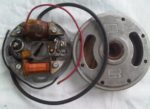

MSL105 ∅82 x 110 aluminum rotor, ∅94 3+2 slot stator
⇐rotation Sinistra, M19-1 puller, type 1
Benelli 70.71.24.00 = G7094/4
1974-on Benelli 3VK with Benelli 3VK engine
1976-on Benelli Export FA with Benelli FA engine
none points xxx 01.3240 = M56/2
$15.0 condenser 07.0074 = M17D


100844 ∅82 x 103 steel rotor, ∅94 3+2 slot stator
⇒rotation Destra, M19-1 puller, type 2
1978? Benelli 3VK-NT (Export FA) with 3VK engine
000 70.71.16.20 M00 none magneto 100884



101662 ∅82 x 103 steel rotor, ∅94 3+2 slot stator
⇒rotation Destra, M19-1 puller, type 2
1978-on Benelli G2 Version A pedali G2 engine
1974-on G2 Elle with G2K engine
071 none 48.71.24.72 magneto 101662?
074 $0.00 48.71.95.70 flywheel nut
061 $2.00 91.60.02.38 woodruff key
102 none 69.70.22.07 base plate
107 $16.0 48.70.88.70 points M18 01.3558
106 48.71.50.71 ignition coil
108 48.71.51.71 lights coil
105 $15.0 35.70.86.00 condenser M17D



101662 ∅82 x 103 steel rotor, ∅94 3+2 slot stator
⇒rotation Destra, M19-1 puller, type 2
Benelli ? with Benelli G2 engine
100 48.71.24.71 M00 1 N/A magneto 101662?
102 69.70.22.07 M00 1 N/A stator plate for 1-piece CEV-left points
103 40.70.95.70 M00 1 N/A G221/11 felt wiper/greaser
104 35.70.79.00 M15 2 $2.50 G221/3 points & condenser screw
104 35.70.79.00 M15 2 $00.0 M4 x 8 small head, replacement
105 48.70.86.70 M00 1 $15.0 G221/6 condenser M17D
106 48.71.50.70 M00 1 N/A spark coil (lower) 1 spark wire
107 48.70.88.70 M18 1 $16.0 points, 1-piece CEV-left-hand type
108 48.71.51.70 M00 1 N/A lights coil 6V 18W (upper) 1 black? wire
109 70.71.89.20 M22 4 $0.20 G221/8 thin lock washer ∅4 x 7 x 0.5
110 35.71.57.50 M25 4 $0.50 G221/7 coil screw M4 x 25 slot
112 48.71.57.70 M00 1 N/A SD404/1 screws and washers kit
113 98.20.04.10 M00 3 $0.70 stator plate screw M4 x 12 slot
’70’s Benelli Turismo 50, Cross 50 with Benelli 4M engine
134 00.00.00.00 427.016.0799 R2063 magneto
150 92.75.00.73 264.004.0799 I9020 flywheel nut
109 91.60.02.38 958.006.0143 G7274 woodruff key
192 00.00.00.00 793.008.0799 R2063/E ign coil screw M5
193 00.00.00.00 772.001.0799 R2063/B base plate M5↑, M4↓
194 00.00.00.00 713.009.0799 R2063/F ignition coil
195 48.70.86.70 723.001.0799 G221/6 condenser
197 35.70.88.00 779.001.0799 G221/4 points
198 00.00.00.00 713.010.0799 R2063/C lights coil
199 35.71.57.50 793.041.0799 G221/7 lights coil screw M4 x 25
1978 Benelli Turismo 50 with Benelli 4M engine
’70’s Moto Guzzi 50 TT with Benelli 4M
087 35.71.24.00 000.000.0799 00000 magneto
089 35.06.72.70 000.000.0799 00000 flywheel nut
083 91.60.02.38 958.006.0143 G7274 woodruff key
100 35.70.22.00 000.000.0799 00000 base plate
091 35.71.50.00 000.000.0799 00000 ignition coil
092 35.71.56.00 000.000.0799 00000 ign coil screw
093 35.70.86.00 723.002.0799 G26/2 condenser
095 35.70.88.00 779.001.0799 G221/4 points
096 35.71.51.00 000.000.0799 00000 lights coil
097 35.71.55.00 000.000.0799 00000 lights coil screw
1970-73? Gentleman with engine GM
070 00.00.00.00 427.022.0799 FA3774 magneto
067 00.00.00.00 264.025.0799 G7090 flywheel nut
073 91.60.02.38 958.006.0143 G7274 woodruff key
152 00.00.00.00 772.007.0799 000000 base plate
160 69.70.88.00 779.002.0799 CS0004 points
159 00.00.00.00 713.008.0799 000000 ignition coil
158 00.00.00.00 713.005.0799 N14/C lights coil
154 00.00.00.00 723.003.0799 000000 condenser
Gentleman 2 with engine G2
070 48.71.24.72 000.000.0799 000000 magneto
067 48.71.95.70 000.000.0799 UI7090 flywheel nut
073 91.60.02.38 958.006.0143 G7274 woodruff key
152 69.70.22.07 000.000.0799 000000 base plate
160 69.70.88.00 779.002.0799 CS0004 points
159 48.71.50.71 000.000.0799 000000 ignition coil
158 48.71.51.71 000.000.0799 000000 lights coil
154 35.70.86.00 723.001.0.799 G221/6 condenser
Gentleman 1974 with engine G2
070 69.71.24.15 000.000.0799 0000000 magneto
067 92.75.00.73 000.000.0799 0000000 flywheel nut
073 91.60.02.38 000.000.0799 0000000 woodruff key
152 69.70.22.01 000.000.0799 0000000 base plate
160 69.70.88.07 000.000.0799 0000000 points
159 71.71.50.00 000.000.0799 0000000 ignition coil
158 48.71.51.70 000.000.0799 0000000 lights coil
154 48.70.86.70 000.000.0799 0000000 condenser
Moto Guzzi Chiu with engine G2
fig# Benelli# 00 Benelli# 00000 Dansi#
009 48.71.24.70 000.000.0799 00 00 00 magneto
009 92.75.00.93 000.000.0799 00 00 00 flywheel nut
012 91.60.02.38 000.000.0799 00 00 00 woodruff key
000 00.00.00.00 000.000.0799 00 00 00 base plate
015 48.70.95.70 000.000.0799 40 39 92 felt greaser
016 48.70.86.70 000.000.0799 40 39 66 condenser
017 48 70 88 70 000.000.0799 40 88 00 points
018 48 71 50 70 000.000.0799 40 49 61 spark coil
019 48.71.51.70 000.000.0799 40 29 86 lights coil
020 48.71.57.70 000.000.0799 00 00 00 screw set
Euro model with engine
000 00.00.00.00 000.000.0799 0000000 magneto
000 00.00.00.00 000.000.0799 0000000 flywheel nut
000 00.00.00.00 000.000.0799 0000000 woodruff key
000 00.00.00.00 000.000.0799 0000000 base plate
000 00.00.00.00 000.000.0799 0000000 points
000 00.00.00.00 000.000.0799 0000000 ignition coil
000 00.00.00.00 000.000.0799 0000000 lights coil
000 00.00.00.00 000.000.0799 0000000 condenser
 8. EU models with various engines
8. EU models with various engines

MDL102 ∅82 x 110? aluminum rotor, ∅80 2 slot stator
⇒rotation Destra, type 1, different coils, curvy
$29.0 points xxx 01.3239
$15.0 condenser 07.0074 = M17D


ADL8 ∅82 x 110 aluminum rotor, ∅94 3+2 slot stator
⇒rotation Destra, machined, type 2
$29.0 points xxx 01.3239
$15.0 condenser 07.0074 = M17D


ADL250B ∅82 x 110 aluminum rotor, ∅94 3+2 slot stator
⇒rotation Destra, puller M19-1, type 4
60’s-70’s models
$29.0 points xxx 01.3239
$15.0 condenser 07.0074 = M17D
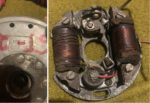

ADL2S ∅82 x 110 aluminum rotor, ∅94 3+2 slot stator
⇒rotation Destra, puller M19-1, type 2
1960’s models
$29.0 points xxx 01.3239
$15.0 condenser 07.0074 = M17D


ADL60 ∅82 x 110 aluminum rotor, ∅94 3+2 slot stator
⇒rotation Destra, puller M19-1, type 2
early 60’s models
$18.0 points 01.3235 = SD5/B
$15.0 condenser 07.0074 = M17D = 1984/F


ASL111 ∅82 x 110 aluminum rotor, ∅94 3+2 slot stator
⇐rotation Sinistra, M19-1 puller, type 5
1968 Beta Camoscio
none points 01.3240
$15.0 condenser 07.0074

Dn60A ∅82? x 110? aluminum rotor, ∅94? 3 slot stator
⇐rotation Sinistra, 20mm condenser (19.8 hole)
1950’s MV Agusta
